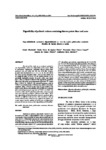Use este identificador para citar ou linkar para este item:
http://www.alice.cnptia.embrapa.br/alice/handle/doc/1035330| Título: | Digestibility of pelleted rations containing diverse potato flour and urea. |
| Autoria: | MARTINELE, I.  PAIVA, P. C. de A.   LOPES, F. C. F.   PEREIRA, J. de C.   FERREIRA, L. R.   |
| Afiliação: | Isabel Martinele, UFJF - MG; Paulo César de Aguiar Paiva, UFLA - MG; FERNANDO CESAR FERRAZ LOPES, CNPGL; Juliana de Cássia Pereira, UFLA - MG; Ludhiana Rosa Ferreira, UFLA - MG. |
| Ano de publicação: | 2015 |
| Referência: | Ciência Rural, v. 45, n. 11, p. 2063-2068, 2015. |
| Conteúdo: | ABSTRACT - The aim of this study was to evaluate ruminal in situ degradability and in vitro digestibility of dry matter (DM) in concentrate supplements containing diverse potato flour pelletized with urea (0%, 4%, 8%, and 12% DM). Samples of feeds were incubated for 0, 2, 4, 8, 12, 24, 36, and 48h in the rumen of four fistulated sheep. Level of urea added had no significant effect (P>;0.05) on the soluble fraction (a) or potentially degradable fraction (b) of the pellets and ranged from 2.1% to 12.2% and 72.9% to 87.5%, respectively. Quadratic effects (P=0.03) of the rate of degradation of fraction "b" ranged from 4.75% h-1to 7.39% h-1; the estimated maximum value at 7.4% h-1was obtained when 5.9% urea was added to the pellet. Quadratic effects (P?0.02) of the level of urea added to the pellets on the effective degradability (ED) of DM were evaluated after considering rumen passage rates of 2.5% h-1and 8% h-1; the maximum values of ED calculated under these rumen passage rates were estimated at 6.3% to 7.3% urea in the pellets. The in vitro digestibility of DM of the pellets showed a quadratic effect (P=0.02) at different levels of urea, with a maximum value of 96.9% achieved when 7.9% urea was added to the pellets. Our results suggest that the addition of 6-8% urea to pelleted feed promotes an increase in the in vitro digestibility and ED of DM. RESUMO - Objetivou-se avaliar a degradação ruminal in situ da matéria seca (MS) e a digestibilidade in vitro de suplementos concentrados a base de farinha de batata diversa peletizada com ureia (0, 4, 8 e 12% da MS). Amostras de cada tratamento foram incubadas por 0, 2, 4, 8, 12, 24, 36 e 48 horas no rúmen de quatro ovinos fistulados. Não houve efeito (P>;0,05) do nível de inclusão de ureia sobre as frações solúvel ("a") e potencialmente degradável ("b") dos péletes, que variaram, respectivamente, de 2,1 a 12,1%, e de 72,9 a 87,5%. Foi observado efeito quadrático (P=0,03) para a taxa de degradação da fração "b", que variou de 4,75 a 7,39% h-1, sendo o valor máximo estimado em 7,4% h-1, obtido quando 5,9% de ureia foram incluídos no pélete. Foram observados efeitos quadráticos (P?0,02) do nível de inclusão de ureia nos péletes sobre a degradabilidade efetiva (DE) da MS, considerando taxas de passagem no rúmen de 2, 5 e 8% h-1e os valores máximos de DE calculadas sob estas taxas de passagem no rúmen foram estimados com 6,3 a 7,3% de ureia nos péletes. A digestibilidade in vitro da MS dos péletes foi influenciada de forma quadrática (P=0,02) pelo nível de inclusão de ureia, com valor máximo de 96,9%, estimado quando 7,9% de ureia foram incluídos no pélete. A inclusão de 6 a 8% de ureia nos péletes promove incremento na digestibilidade in vitro e na degradabilidade efetiva da matéria seca. |
| Thesagro: | Solanum Tuberosum |
| NAL Thesaurus: | ruminants |
| Palavras-chave: | Alternative feeds Pelletization |
| Digital Object Identifier: | https://doi.org/10.1590/0103-8478cr20141234 |
| Tipo do material: | Artigo de periódico |
| Acesso: | openAccess |
| Aparece nas coleções: | Artigo em periódico indexado (CNPGL)  |
Arquivos associados a este item:
| Arquivo | Descrição | Tamanho | Formato | |
|---|---|---|---|---|
| Cnpgl2015CiRuralDigestibility.pdf | 289,86 kB | Adobe PDF |  Visualizar/Abrir |









